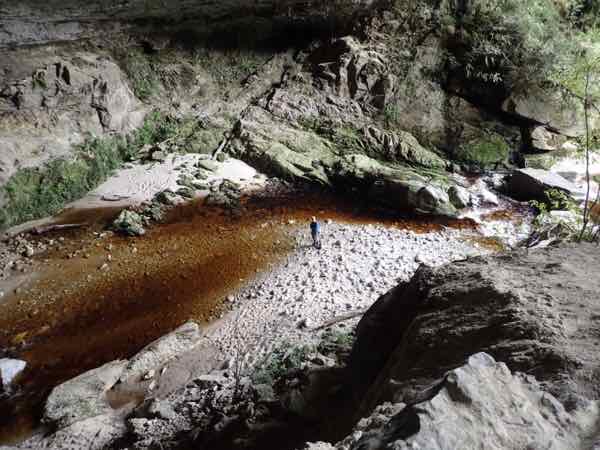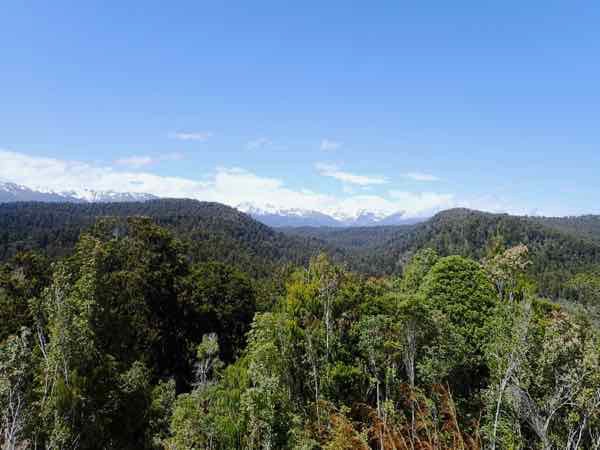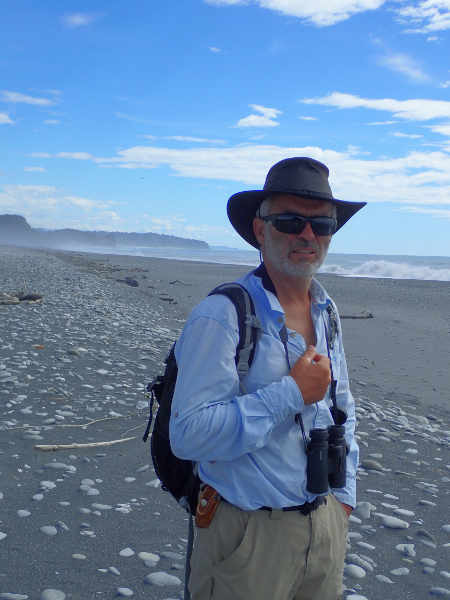A whistle stop tour of the west coast (South Island NZ)

43:17.44S 170:13.28E Angie was waiting for us down a city side street in Nelson. She looked in good shape and was travelling with two very compact backpacks. We shoved the bags in the back, squeezed into the front seats and headed south. Angie and I have been friends for decades. We worked together on various rainforest and peace campaigns years ago in Norwich. Then, shortly before we sailed, Angie moved to Knighton in Wales and we were able to see more of each other. Last year when we were in Chile, she came out to visit us with our mutual friend Julie.  Angie at Pancake Rocks For Franco and I, ‘New Zealand’ conjured up strange flightless birds, amazing forests and pristine wilderness. We hoped to meet the kea, a large alpine parrot. So far we had enjoyed close encounters with red-billed gulls and variable oystercatchers.  Red-billed gull (Larus scopulinus), ‘Tarapunga’ in Maori, status: threatened  Variable oystercatcher (Haematopus unicolor), ‘Torea tai’ in Maori, status: at risk Angie had planned on bringing a book about New Zealand birds but when she realised most of them had been introduced from Europe, she left it behind. Before arriving in NZ, Franco and I hadn’t grasped the scale of the problem. We’d heard about the extinction of moa, a large flightless bird similar to an ostrich, and we knew that the introduced rats had predated many small native birds but we hadn’t realised that around sixty bird species (nearly half of all land species) had been wiped off the face of New Zealand since humans arrived.
“Bloody white settlers!” I hear you say, and for sure they did have a serious impact but much of the damage had been done by the time Cook arrived. The Polynesians settled around a thousand years ago and hunted the moa and many other species to extinction. The demise of the moa led to the extinction of the Haast eagle. The Polynesian rat, which came with the humans, decimated song bird populations. It is true that New Zealand had an incredible diversity of avian life, often the North Island, South Island and Chatham Island varieties of a particular type of bird would all be distinct species, but each population remained relatively small. It is the sorry tale of the extinct ‘laughing owl’ (Sceloglaux albifacies) that struck me the most. The Polynesians arrived, bringing with them the Polynesian rat. The rats ate the native prey that the owl depended on. The laughing owl adapted and switched to eating rat. Then the European settlers disembarked along with the European rat. The owl added ‘big rat’ to its diet, there was nothing else, the rats had eaten everything. The last nail in the coffin for the laughing owl was the introduction of stoats to control the rabbits (also introduced) and the cats that had gone feral. The owl no longer laughed. In our haste to get out of town, I hadn’t stocked up on food. On the map it looked like we would be passing through numerous settlements so there was bound to be a grocery store somewhere! The names on the map turned out to be single homesteads, not villages, and other than a dozen eggs, bought from a farm honesty box, by the time we arrived at Kawatiri where we planned to stop for the night, we still had no food. My promise of a delicious omelette fell on deaf ears so we continued to Murchinson where there was a small supermarket. As Kawatiri had looked more like a lay-by than a campsite, we drove on to Lyell, in the Buller Gorge, where there is a Department of Conservation (DoC) campsite. It was dusk and raining when we pitched Angie’s tent. The next morning we went for a walk and saw a large pigeon-like bird perched on a branch. We were amazed at how close it let us approach. It seems that in New Zealand binoculars aren’t necessary, either birds are too close to focus or so well camouflaged you only ever hear them. New Zealand pigeon (Hemiphaga novaeseelandia), ‘Kereru’, ‘Kuku’ or ‘Kukupa’ in Maori, status: abundant Our journey continued down the Buller Gorge, all the way to the ocean and the small town of Westport, authentically gritty. Angie was interested in going to see the Oparara limestone arch so we turned right an headed north up the coast. It was a lot further than we had thought to Karamea and the road was very windy. The final 14km were along a narrow, gravel track. The arch was impressive and the surrounding forest very beautiful. We would have liked to spend a whole day wandering the various paths but the sun was setting and camping was not allowed, so we headed back down and camped at another DoC site, by the beach at the end of the Heaphy walking track. Here we well and truly became acquainted with New Zealand’s ‘sandflies’. They are in reality a small black fly (Austrosimulium ungulatum) and only the females bite. They need a blood meal before they lay their eggs. Penguins are apparently their favourite diet but they seemed to find Angie a good substitute, and with Franco around as well, I got off lightly.  Oparara Arch - 200m long and 37m high  Franco standing under the arch The following morning, after another ‘duck the sandflies’ session over breakfast, we retraced our tyre tracks to Westport and carried on south. Pancake Rocks was our destination but we stopped off en route at the Truman Track. This was a well interpreted short walk from high forest down to the foreshore.  Truman Track - the temperate rainforest resembles a tropical jungle We learnt that the strange palm trees we’d seen on farmland are called ‘Nikau palm’ and are native to New Zealand. The tallest trees in the canopy were Rimu (Dacrydium cupressinum), in the Podocarp family, and sought after for their timber.
Rimu (Dacrydium cupressinum) The climbing shrub Kiekie (Freycineta banksii) gave the forest an exotic feel, it is in the Pandanus family and prized by the maoris for weaving. The fruit is allegedly very sweet.
Kiekie (Freycineta banksii) As we approached the beach, forest gave way to ‘flax’. It was used by Maori and early explorers to make ropes, fishing nets and for weaving. Only three leaves were harvested at a time, to conserve supplies. Despite its name, it isn’t related to flax at all!
‘Flax’ (Phormium tenax) or Harakeke to the Maoris On the beach we looked for blue penguins but didn’t find any trace. Pancake Rocks was very touristy. There was a visitor centre, a café selling pancakes(!) and hundreds of people on the pancake ‘motorway’, all jostling to take photos. In Maori, this place is called ‘Punakaiki’ and we’d speculated about which word had come first. Of course it was the Maori, ‘puna’ meaning ‘spring’ and ‘kaiki’ meaning ‘heap’ (of rocks), but the Europeans could be forgiven as the rocks do look a bit like mounds of pancakes!
Punakaiki It was time for a shower. We sped through Greymouth (unfortunate name) and pulled into a commercial caravan park on the outskirts. The price was outrageous so we continued onto the next one which was part of the Kiwi chain. The price was fair and the facilities very good, we even made some friends in the kitchen, an Australian couple and a French shepherd with a job further south. Angie’s friends had recommended Okarito Lagoon as the best place to see the endangered native white heron (Ardea alba modesta). In fact Okarito is the only breeding site and the bird is rarely seen except by those who specifically seek it out. We pulled into a car park advertising a short walk with good views. As we were about to set off, I realised I’d forgotten the camera in the van. I grabbed it quickly and headed off up the path, expecting to catch Angie up. Twenty minutes later I arrived at the top, there was no sign of Franco or Angie. “Oh dear, Franco will give me a hard time about this!” I thought. I was definitely on the route we had agreed to take but I had noticed another path out of the car park. I hurried back and set off down the other track. I was about to give up when three people suddenly appeared from around the corner walking towards me. I asked if they’d seen Franco and Angie. “We’ve seen no one,” they replied. “We didn’t go all the way, it’s bloody miles and there aren’t any views.” They complained. “That’s because you are on the wrong track.” I said smugly. They didn’t believe me! I decided to turn around but just in case, tried calling out. Franco and Angie answered, they were on their way back, then Franco appeared, marching briskly and muttering something about views. We ate our pack lunches at the view point.
Okarito Lagoon and the coast on one side
The Southern Alps and the Franz-Josef Glacier on the other Ten minutes down the road, we stopped by the lagoon, there wasn’t a single heron. We had high hopes of the ‘Wetland boardwalk’, but saw nothing. The path climbed steadily, parallel to the coast with great views.
The rugged coast We continued to the Waiho River and for the first time since we arrived in New Zealand, felt like we were on the edge of a wilderness.
Franco, the great explorer
View towards glacier country
Angie A possible way back to the vehicle was along the beach at low water. As the tide was going out, we set off, scrambling over the boulders. It was slow going but eventually we were able to walk along the beach and got back to the van dry and in one piece. As we were driving away, at last we spotted two white heron, immobile on the opposite shore. That night we camped near Franz-Josef, and enjoyed a night on the town. In the morning we would visit the glacier. |
 ,
,







